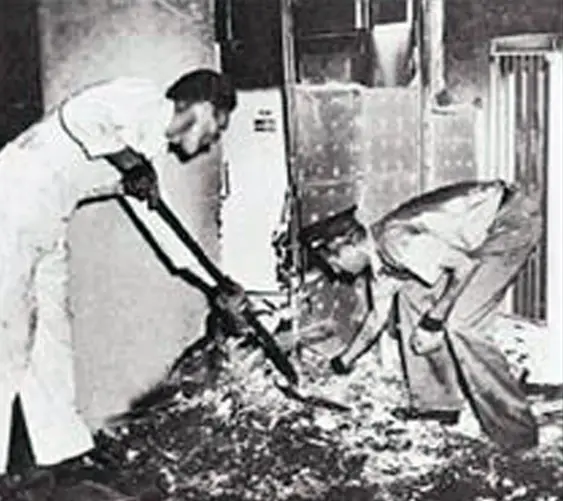Could these documented cases of spontaneous human combustion be real? Fires are always a tragedy, especially when they result in the loss of life. Fires can destroy a person’s entire life in mere minutes. Whenever a fire tears through a house, people always want to know what caused it. Well, what if that question had no answer? That is exactly the case in these five horrifying stories of spontaneous human combustion.
5. Jeannie Saffin

The death of 61-year-old Jeannie Saffin in 1982 is one of the most frequently discussed cases of supposed spontaneous human combustion in history. Unlike most of the victims of these mysterious events, Jeannie was not alone when her body burst into flames.
Jeannie was born with significant disabilities, so she spent her entire life living in her parents’ home. On September 15, 1982, she was in the kitchen of her parents’ home with her father and brother-in-law. The two men weren’t paying much attention to Jeannie until they saw a bright light out of the corner of their eyes. They turned to Jeannie and saw that she was inexplicably on fire.
They quickly began dousing Jeannie with water to put out the flames and called for an ambulance. She was treated for her severe burns for a total of eight days until she died from her injuries. The cause of death was listed as broncho-pneumonia due to burns.
An inquest was held into the circumstances surrounding Jeannie’s death. At the inquest, Jeannie’s family asserted that they believed it to be a case of spontaneous human combustion. According to Jeannie’s father, he had witnessed flames shooting out of her mouth that made a terrifying roaring noise. He said that the image brought to mind a dragon breathing fire. Jeannie’s family also claimed that the clothing Jeannie had been wearing was untouched by the fire. Later research proved that this was untrue.
The coroner at the inquest rebuffed the family’s claims, insisting that humans cannot spontaneously catch fire. Researchers later put forth the theory that the fire had been caused by the pilot light from the family’s kitchen stove. Anecdotal evidence suggests that there were windows open in the kitchen that would have caused a cross-breeze that could have blown the flame toward Jeannie and set her alight.
Many are skeptical of the more mundane explanations for the fire that tragically ended Jeannie’s life. Those who believe that she combusted point to her father’s testimony of flames coming from her mouth as evidence that the source of the fire was Jeannie’s body itself.
4. Robert Francis Bailey

Not all victims of spontaneous human combustion have family members to bear witness to their passings. In the case of Robert Francis Bailey, he was alone in an abandoned building when his body caught fire.
Robert was known as an alcoholic. It is believed that he was seeking shelter from the cold inside of the building where he died on September 13, 1967. A person walking by called the fire department when he saw a bright light coming from inside the building.
Within five minutes, a fire crew was on the scene. They found Robert on the floor, curled up as if he had pain in his stomach. The firemen reported that he had a slit in his stomach, measuring about four inches, from which the flames seemed to be coming. They later described the flames as blue and looking like the flames from a blow-torch. Robert was still alive when the crew arrived. They reported that he was writhing in pain and appeared to be biting into a stair post. The crew later had to pry his jaw open around the post to remove his body from the scene after emptying several fire extinguishers to put out the flames.
There were other odd aspects of the case. Nothing else in the room other than Robert’s body was on fire. After putting it out, the fire crew found little fire damage in the room or Robert’s clothing. Only the part of his shirt covering his stomach and a bit of the floor below his body were charred. They noted that there were several highly flammable substances in the room, but none of them had caught fire.
A later inquest hypothesized that the fire had been caused by Robert dropping a cigarette onto his shirt. However, the lack of surrounding damage and the speed with which the flames seem to have grown make that theory unlikely. Additionally, skeptics note that a fire caused by a dropped cigarette wouldn’t have been bright enough to attract attention from outside.
3. Mary Reeser

On July 2, 1951, 67-year-old Mary Reeser became a victim of spontaneous human combustion. Like many of the victims of this terrifying phenomenon, Mary was alone at the time that her body apparently burst into flames.
Mary lived alone in an apartment. On the day that Mary died, her landlady knocked on Mary’s door to deliver a telegram that had arrived for her. When no one answered, she tried the doorknob. The knob seemed strangely hot to her, so she called the police.
The police arrived and discovered that whatever fire had occurred in the apartment was already out. They found Mary’s remains on a chair. Her body had mostly been reduced to ash. All that remained was her slippered foot, her spine, and her skull. The skull was one of the most unusual aspects of the case. According to investigators,it had shrunk to the size of a teacup. They confirmed that the skull had shrunken too much for the burning of her facial features to be the cause.
Investigators also noted that there was very little damage to the room. A few plastic objects had melted just enough to morph their shapes, but nothing else appeared to be damaged. They didn’t even find much smoke damage in the room.This is a perplexing detail, as it requires temperatures of at least 1,600 degrees Fahrenheit (870 degrees Celcius) to reduce a human body to ash.
At an inquest, an FBI investigator speculated that because Mary was known to use sleeping pills, it was plausible that she had fallen asleep smoking. However, other investigators disputed this claim, asserting that it would be impossible for a fire caused by a cigarette to reach temperatures high enough to fully cremate a human body.
2. George Mott

On March 26, 1986, Kendall Mott, the son of retired fireman George Mott, begun to worry that his father hadn’t been answering his repeated phone calls. According to testimony from his family and friends, George was depressed and suffered from lung problems that required him to use an oxygen tank in order to breathe. This kept him at home most of the time.
Kendall decided to drop in on George to check on him. When he arrived at his father’s home, he noticed that all of the house’s windows appeared brown. On the inside of the house, the air appeared smoky and smelled like something had been burnt. George had formerly been a smoker but quit because of his lung problems, so the smell was certainly unexpected.
Then, Kendall found his father. Or what remained of him. All that was left was a pile of ashes and a few pieces of bone. Authorities noted that the damage was similar to what would happen to a body that had been professionally cremated.
More perplexing were the inconsistencies in the room. A nearby television had melted, but the bedding on which George’s body had been incinerated was largely untouched. There was also a book of matches on the bedside table that hadn’t ignited. Investigators also noted that George’s oxygen tank was still running and hadn’t been damaged, nor had the face mask. How had George’s entire body been turned to ash, but the mask that he must have been wearing in order to breathe was untouched?
The official theory was the George had decided to light a cigarette to help cope with his depression, removing his mask in the process. However, this doesn’t explain how the fire had been hot enough to cremate George’s body, yet hadn’t damaged his bedding. Many believe he was killed as a result of spontaneous human combustion.
The case of George Mott will remain in a niche group of alleged supernatural deaths that authorities may never be able to explain.
1. John Irving Bentley

Dr. John Bentley was a 92-year-old scientist when he became a victim of spontaneous human combustion. On the morning of December 5, 1966, a meter-reader entered Dr. Bentley’s home, having standing permission to enter unannounced due to the scientist’s advanced age. He went into the basement to check the meters where he noted blue smoke that he described as sweet-smelling. He then saw a large pile of ashes on the floor; the floor underneath had no evidence of burns, but there was a large, square hole in the ceiling above. He went upstairs to investigate.
Upstairs, after passing through a smoky bedroom, the man found the remains of Dr. Bentley in the bathroom. All that he found was a pile of ashes and the lower half of the scientist’s right leg, the foot still clad in a slipper. He quickly called for help, panicked at the sight, but clearly, Dr. Bentley was beyond saving.
There were numerous theories about the death. Some speculated that Dr. Bentley had set himself alight with his pipe. However, the pipe was found unlit on the bedside table. Others noted that the man’s clothing was found smoldering in the bathtub, leading them to believe that his clothes had caught fire from the matches in the pocket. They asserted that Dr. Bentley had likely awoken to find his clothes on fire, run to the bathroom and removed the robe, but died before being able to put out the fire. However, a fire hot enough to fully cremate the scientist’s body was unlikely to have been started by a random spark to an unlit match.
—
So there’s our look at some terrifying cases of spontaneous human combustion. Do you think this condition could be real? Let us know in the comments below or on any of our socials.







